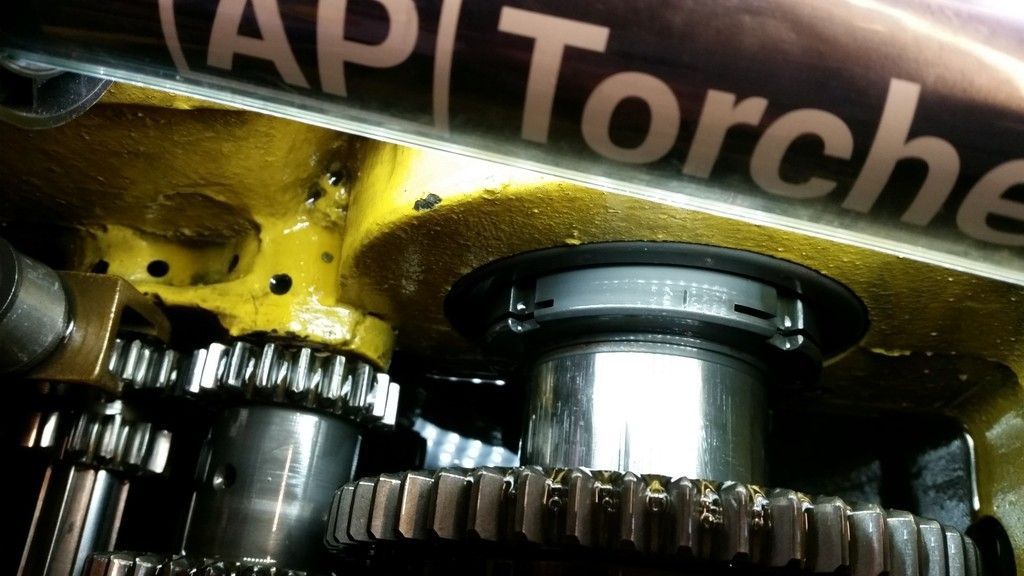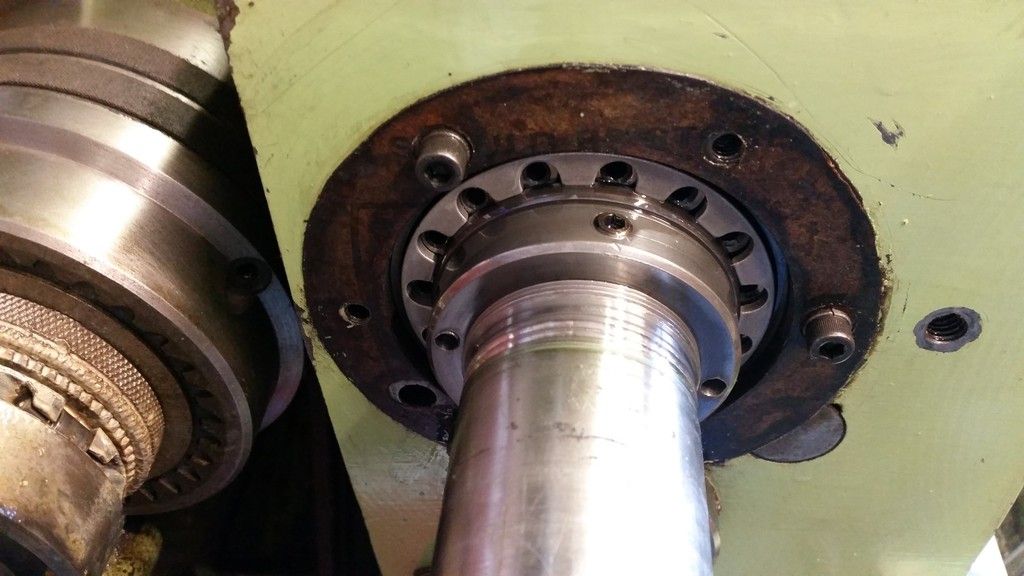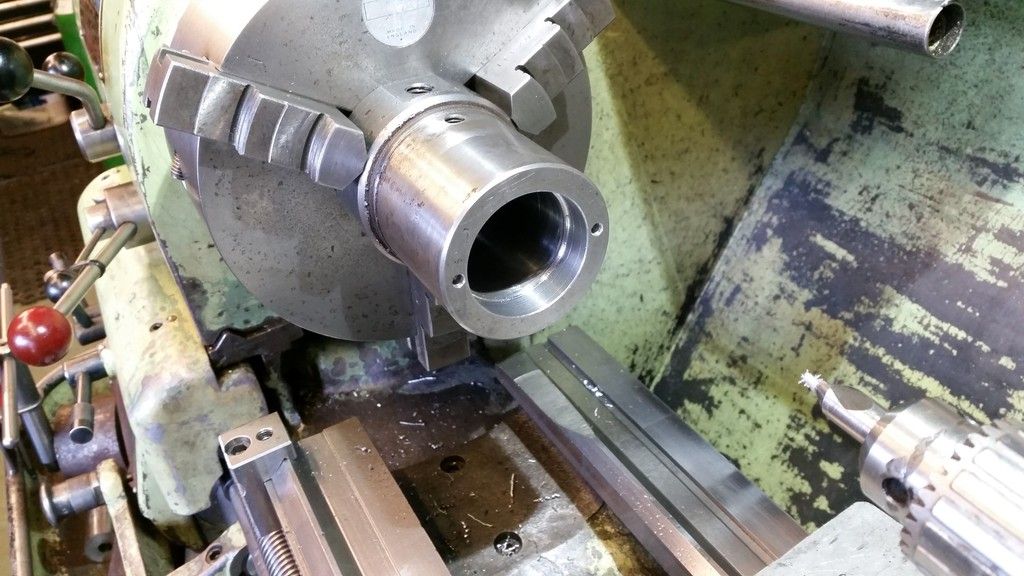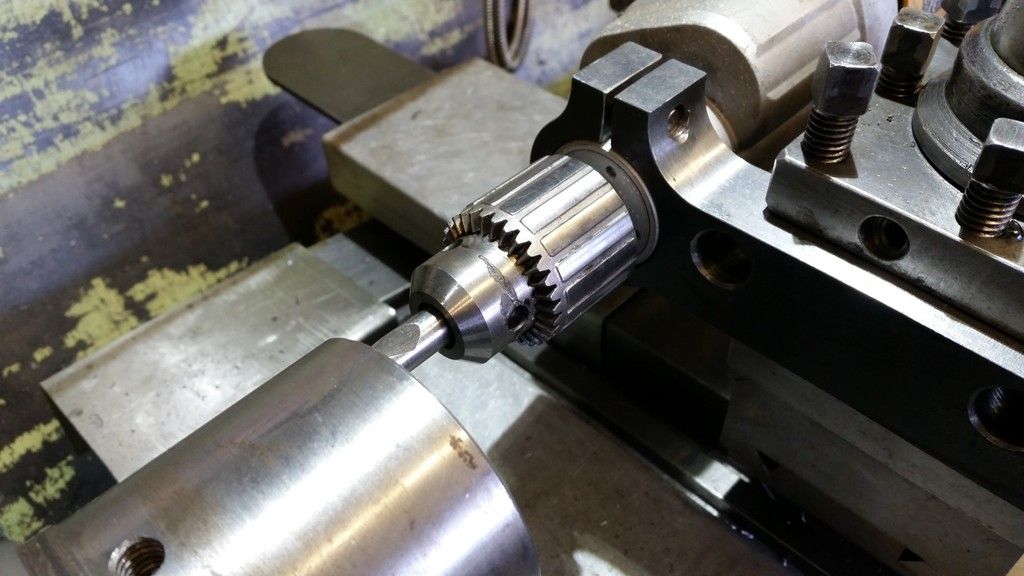Spindle bearing adjustment
| Bernard Wright | 15/05/2016 07:29:29 |
90 forum posts 16 photos | Hi All, Is there anyone on here whom has adjusted, or has knowledge of how to adjust, the spindle bearings of a 1967 Colchester Master Roundhead, Help would be appreciated. Bernard |
| frank brown | 15/05/2016 07:34:14 |
| 436 forum posts 5 photos | According to :- http://www.lathes.co.uk/colchester/page2.html they run in precision ball bearings. Frank |
| Bernard Wright | 15/05/2016 08:23:31 |
90 forum posts 16 photos | Thanks for the reply Frank, quite a lot of info on Tony's site, but it doesn't give any detailed info on how to adjust the spindle bearings. They look as though they can be, due to what looks like an adjusting nut behind the bearings. I'm getting a thou deflection at the extreme end of a new MT4 test bar, bought from our friends at Arc. The deflection noticed is not by pushing on the bar, but on the L0 taper stub before the bar. I can get 2 to 2 1/2 thou pushing on the bar itself near the extreme end. I realise this is not a lot of play, but was surprised to see any, from the bearings in such a sturdy machine. Bernard |
| Michael Gilligan | 15/05/2016 12:04:48 |
23121 forum posts 1360 photos | Bernard, I would not expect to see/feel any perceptible play ... if there is an adjusting nut on a ball-bearing spindle, it's usually for setting preload. That said: I don't know the detail of this head ... So please wait for some expert advice before making any potentially expensive changes !! MichaelG. |
| KWIL | 15/05/2016 12:49:56 |
| 3681 forum posts 70 photos | The lathes.co.uk states they run on Gamet precision bearings. These bearings are expensive. Adjustment is done when they are at a warm temperature after running and are set for preload to give a defined bearing torque. In the case of similar bearing, in a Harrison M300 this is 0.9/1.1Nm (= 160mm chuck with string to give a 1.14/1.36Kg load) with spindle just turning as the spring balance is pulled away. May be similar to OP's machine, as MichealG says I would not expect to see/feel any perceptible play. Edited By KWIL on 15/05/2016 12:50:45 |
| Neil Wyatt | 15/05/2016 14:56:59 |
19226 forum posts 749 photos 86 articles | +1 to what KWIL and Michael have said, taper rollers should have carefully adjusted preload. The main thing to watch for is that the headstock doesn't get more than warm after extended running. Too much preload will be apparent as relatively rapid heating and will damage bearings. |
| Bernard Wright | 15/05/2016 20:32:05 |
90 forum posts 16 photos | Thanks Guys for all the replies. I'm going to try to contact someone at the Colchester arm of the 600 Group tomorrow. On this headstock setup, the spindle bearing locknut is also locked, with 2 opposing countersunk allen screws, the key size for these is 1/8", fit is rather sloppy, so will try to regrind a 4mm key to a snugger fit, should it be required.. The test bar has also highlighted other issues, like upward tilt of the spindle of 1&1/2 thou, and lateral misalignment of 2 thou towards the front... this beggars belief, because unsupported turning produces a larger diameter at the outer end.. So some remedial work is imminent... Bernard. |
| Neil Wyatt | 15/05/2016 21:21:55 |
19226 forum posts 749 photos 86 articles | > So some remedial work is imminent... Please don't do anything until you have adjusted the bearings and repeated the measurements, it could just be pressure from gears or drive belts biasing the spindle one way or t'other. More than one 'fundamentally inaccurate machine' has turned out to have a loose spindle. Neil |
| Nick_G | 15/05/2016 21:25:35 |
1808 forum posts 744 photos | Posted by Bernard Wright on 15/05/2016 20:32:05:
because unsupported turning produces a larger diameter at the outer end..
Bernard. . It usually does. - That is the whole idea and reason work whenever possible is supported by a centre at the tailstock. But this of course will depend on the length and diameter of the unsupported stock. I would l like to be 100% sure (then plus another 10% for good measure) it was not a tailstock / bed wear issue before I jumped in altering the headstock alignment.
Nick |
| Ajohnw | 16/05/2016 00:07:55 |
| 3631 forum posts 160 photos | Apart from the work bending the best test for loose bearings is the same cut recutting again. Taper can just be down to bed wear. Early signs are pretty easy to check as well. Say 12" of 2" dia bar and moderate cuts and a centre in the end- maybe 20 thou or lighter and a fine feed. If there is slight play in the spindle it will be possible to get a good finish but rings will appear along the work from time to time. Coarser feeds or even heavier cuts will cause them to go or lessen. Being fair though it can take 15-20min for the bearings in a lathe like that to warm up. I assume it's a gear head.The front face of the headstock should feel nice and warm then, cosy warm is the only way I can describe it. Boxfords are set with a spring balance, catch plate with rope around it so that the torque caused by pre load can be measured. There are mixed feelings about it working on a lathe that has seen some use. There is a sort of fix for that but it wont work out on a gear head. Mine has been set as good as it can get but it still leaves a very slight problem - the bearings have worn slightly oval - it just makes a couple of 1/10 thou difference to the work in the form of a recut near the end and for best finish I can't always use the finest feed with very light cuts. John - |
| Bernard Wright | 16/05/2016 12:37:28 |
90 forum posts 16 photos | Hi All, Again thanks for all the replies... I spoke to someone at 600UK/Colchester Lathes today, whilst there is no-one there familiar with the old types of lathe, he asked me for my machine number and raised some info on their system. Boils down to trying the rear adjusting nut first, this bears up against the rear bearing, which is pressurised by some springs held captive by an internal plate, secured by three allen bolts sunk into another external housing which holds the seal and covers the rear bearing. When I get it stripped I'll post some pics, to illustrate what I've been banging on about... The gent at 600UK said as a last resort try the front bearing adjustment, but if I go too far (too tight), just slackening the nut won't release the pressure, I'll have to give the rear of the spindle a sharp tap, after loosening, but not with a 14 pounder... Bernard. Edited By Bernard Wright on 16/05/2016 12:39:01 |
| Ajohnw | 16/05/2016 21:07:31 |
| 3631 forum posts 160 photos | There is a manual for the lathe here Might be of interest. It does look to be the round head and not too bad a photo copy.
John - |
| Bernard Wright | 16/05/2016 22:20:53 |
90 forum posts 16 photos | Thanks for the link John, I found I'd already downloaded that one along with several others, sadly none of them give any details I really require. I took the lathe down a stage today and did some pics, but haven't altered anything yet, even did a bit of turning to make a pin spanner to engage the rear locknut... This is the front bearing locknut... 2nd is the rear locknut...3rd is the pin spanner drilled for 3/16" pins to tighten the rear locknut...
Method of drilling in my lathe...
Bernard |
| Ajohnw | 16/05/2016 23:37:05 |
| 3631 forum posts 160 photos | The bearing numbers are about on the web - I only saw them for the 2500 though but the older type will be probably be about too. This is the gamut catalogue Might pay to find out what they are and look like before trying to adjust them. John - |
| KWIL | 17/05/2016 14:32:40 |
| 3681 forum posts 70 photos | I am horrified that anyone would suggest "a sharp tap" on anything near a Gamet bearing, unless you are intent on changing it! Looking at the IPB in the Manual, it would appear that the "nut" on the front bearing can only be holding the centre bearing element to the spindle nose and does not play any part in the overall preload. Normal use of taper roller bearings is that the total preload is applied solely by the "nut" on the spindle rear pulling both bearing centres together, and hence preloading the whole. There will undoubtedly be a firm, nay tight fit between the bearing inners and the spindle and that a puller of some sort may well be necessary to lighten the preload should you be so unfortunate as to set it too high. Owing to a leaking front oil seal on my Harrison M300 I had to displace the spindle and to make a hydraulic puller frame to achieve any movement. |
| KWIL | 17/05/2016 14:40:13 |
| 3681 forum posts 70 photos | Had a further look at the IPB Illustration and List, no sign of any springs associated with the spindle bearings that I can see. Anyone else see better? |
| Ajohnw | 17/05/2016 16:27:55 |
| 3631 forum posts 160 photos | I suspect the same KWIL - bull from colchester. I do reckon it would be worth checking actual bearing numbers though 'cause if colchester want to use the words toolroom accuracy the front bearing may well be a double taper bearing in a single shell or even a pair. The lock nut at that end will then set the front bearing preload. That's one option but another which I doubt is that it is some sort of roller rather than taper. The reason for the use of double bearing at the front of the headstock is down to temperature effects when they heat up. This get far more important as the spindle gets longer. Simple taper cones at each end are pretty useless past some point hence people like Lang, DSG, CVA using doubles at the front. When some one showed details of another colchester it did just use a cone at each end. It'll be no better than my Boxford or many well adjusted Chinese lathes up to some length of spindle. Probably worse due to the size of the lathe. John - |
| KWIL | 17/05/2016 16:55:30 |
| 3681 forum posts 70 photos | Here you are, a list of Gamet bearings used.
|
| Ajohnw | 17/05/2016 17:18:48 |
| 3631 forum posts 160 photos | It might pay Bernard to look further in case the 2500 is different or if there were specials like the Triumph. The Triumph I suspect did use "toolroom" bearing but only because I have seen a number of them in toolrooms. (Lucas) Just add a quick complaint about lathes co uk. Every time I look at buying some lathe or the other I look on there to see if the style of headstock bearings are mentioned John - Edited By Ajohnw on 17/05/2016 17:22:19 |
| Jez | 17/05/2016 18:49:34 |
| 58 forum posts 1 photos | Hi John, FYI - I found out the other day that simplybearings.co.uk have started stocking some Gamet bearings. Don't know how their prices stack up against buying direct from 600 Group though, or if they stock the Roundhead Master ones. They stock Master 2500 spindle bearings though. HTH! Jez. |
Please login to post a reply.
Want the latest issue of Model Engineer or Model Engineers' Workshop? Use our magazine locator links to find your nearest stockist!
Sign up to our newsletter and get a free digital issue.
You can unsubscribe at anytime. View our privacy policy at www.mortons.co.uk/privacy
- hemingway ball turner
04/07/2025 14:40:26 - *Oct 2023: FORUM MIGRATION TIMELINE*
05/10/2023 07:57:11 - Making ER11 collet chuck
05/10/2023 07:56:24 - What did you do today? 2023
05/10/2023 07:25:01 - Orrery
05/10/2023 06:00:41 - Wera hand-tools
05/10/2023 05:47:07 - New member
05/10/2023 04:40:11 - Problems with external pot on at1 vfd
05/10/2023 00:06:32 - Drain plug
04/10/2023 23:36:17 - digi phase converter for 10 machines.....
04/10/2023 23:13:48 - More Latest Posts...
- View All Topics
- Reeves** - Rebuilt Royal Scot by Martin Evans
by John Broughton
£300.00 - BRITANNIA 5" GAUGE James Perrier
by Jon Seabright 1
£2,500.00 - Drill Grinder - for restoration
by Nigel Graham 2
£0.00 - WARCO WM18 MILLING MACHINE
by Alex Chudley
£1,200.00 - MYFORD SUPER 7 LATHE
by Alex Chudley
£2,000.00 - More "For Sale" Ads...
- D1-3 backplate
by Michael Horley
Price Not Specified - fixed steady for a Colchester bantam mark1 800
by George Jervis
Price Not Specified - lbsc pansy
by JACK SIDEBOTHAM
Price Not Specified - Pratt Burnerd multifit chuck key.
by Tim Riome
Price Not Specified - BANDSAW BLADE WELDER
by HUGH
Price Not Specified - More "Wanted" Ads...
Do you want to contact the Model Engineer and Model Engineers' Workshop team?
You can contact us by phone, mail or email about the magazines including becoming a contributor, submitting reader's letters or making queries about articles. You can also get in touch about this website, advertising or other general issues.
Click THIS LINK for full contact details.
For subscription issues please see THIS LINK.
Model Engineer Magazine
- Percival Marshall
- M.E. History
- LittleLEC
- M.E. Clock
ME Workshop
- An Adcock
- & Shipley
- Horizontal
- Mill
Subscribe Now
- Great savings
- Delivered to your door
Pre-order your copy!
- Delivered to your doorstep!
- Free UK delivery!

 That encourages good practice - turn to a size with decent cuts and get them right rather than trying to remove some few thou's with one.
That encourages good practice - turn to a size with decent cuts and get them right rather than trying to remove some few thou's with one.












 Register
Register Log-in
Log-in


